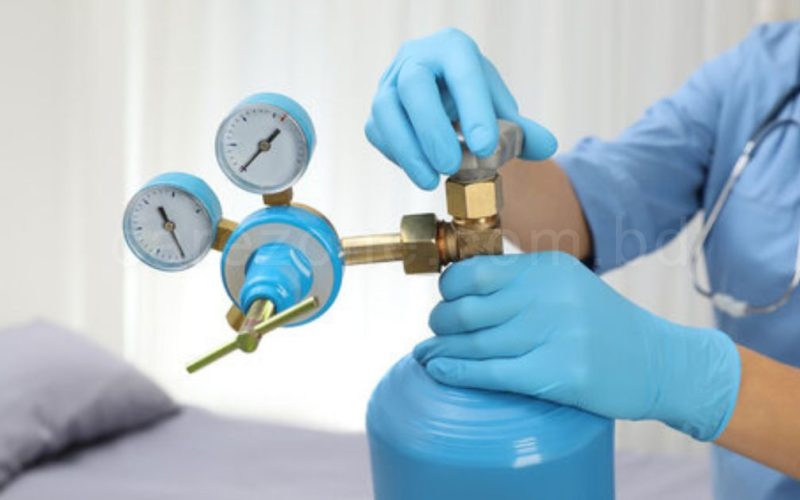Introduction
If you or a loved one needs oxygen therapy at home, it can feel overwhelming at first. The idea of handling medical equipment may seem complicated. But the truth is, with the right guidance, you can manage it safely and confidently.
Many people only worry about the oxygen cylinder price in BD, but safety and correct use are just as important. When you know how to handle, store, and operate it, you reduce risks and ensure your patient gets the full benefit of oxygen therapy. Let me walk you through everything you need to know.
Understanding How an Oxygen Cylinder Works
Before you use an oxygen cylinder, you need to understand what it does. Think of it as a pressurized tank filled with pure oxygen. The gas flows out through a regulator and reaches the patient through a mask or nasal cannula. Simple, right?
When you set it up, the regulator controls how much oxygen comes out. Too high or too low flow can affect the patient. That’s why you should always follow your doctor’s prescription. Never guess the flow rate yourself.
Another thing you need to know is the pressure gauge. This little meter tells you how much oxygen is left in the cylinder. If you see the needle dropping close to zero, it means you’ll need a refill soon. By checking it regularly, you’ll never run out of oxygen in the middle of an emergency.
Placing the Cylinder in a Safe Location
Where you keep the cylinder matters a lot. You should place it upright in a stable position. If it tips over, the regulator can break, and that can be dangerous. Some people use a stand or a trolley to keep it steady, which is a smart choice.
Keep it in a cool, dry area away from direct sunlight or heat sources. Oxygen supports combustion, so avoid placing it near stoves, heaters, or candles. You don’t want to create any fire risk.
Also, make sure the cylinder is easy to reach. If you suddenly need it at night, you shouldn’t struggle to move it. By setting it in a safe and accessible spot, you make life easier for both the patient and caregiver.
Learning How to Operate the Cylinder
When you’re ready to use the oxygen cylinder, first check that everything is clean. Dust or dirt around the valve can cause problems. Use a dry cloth to wipe it before use.
Next, open the main valve slowly. If you open it too quickly, the pressure might shock the regulator. Once it’s open, adjust the flow rate according to your doctor’s instructions. This step is critical because every patient needs a different amount of oxygen.
Finally, fit the mask or nasal cannula properly. If it’s too loose, oxygen escapes, and the patient won’t get the right dose. If it’s too tight, it can cause discomfort. Take a few seconds to adjust it so the patient feels comfortable and gets the oxygen they need.
Safety Precautions You Must Follow
There are some rules you should always follow when handling oxygen at home. Never smoke near the cylinder. Even a tiny spark can be dangerous. If you have visitors, remind them too.
Always keep oil and grease away from the cylinder valve. Oxygen reacts strongly with these substances and can cause fire hazards. Use only equipment approved for oxygen therapy.
You should also keep a backup cylinder if the patient depends on long-term oxygen therapy. Imagine if your cylinder runs out suddenly at night. Having a spare can save the day. Think of it as insurance for your health.
Maintenance and Refilling
To keep your cylinder in good shape, you must care for it regularly. Check the pressure gauge daily so you know when to refill. Don’t wait until it’s completely empty because emergencies can happen anytime.
When refilling, always choose a trusted provider. Not all suppliers maintain quality standards. Poorly refilled cylinders may contain impurities, which are harmful to patients. If you’re buying or refilling, check the provider’s reputation. Some reliable services even offer doorstep delivery of oxygen cylinder BD units.
Also, follow up on servicing. Regulators, gauges, and masks need to be checked. If anything looks damaged, replace it immediately. Small parts play a big role in safety.
Considering Portability for Home Patients
Sometimes patients need oxygen while moving around the house or traveling. This is where smaller cylinders come in handy. If you’re looking for convenience, you might want to compare the portable oxygen cylinder price in BD. These are lighter, easier to carry, and still provide enough oxygen for short-term use.
For patients who feel weak but still want to move from room to room, portable options make life less restrictive. They can sit in the living room, take fresh air on the balcony, or even visit the doctor without worrying about oxygen supply. Choosing the right type depends on the patient’s lifestyle and medical needs.
Final Words
Using an oxygen cylinder at home may feel challenging at first. But once you learn the right steps, it becomes manageable. Safety should always be your priority, from storing and operating the cylinder to keeping it well-maintained.
Whether you’re looking at the oxygen cylinder price, choosing between sizes, or arranging refills, remember that safety and reliability matter just as much as cost. With the right care, you ensure better health and peace of mind.
FAQs
Q1. How long does a medical oxygen cylinder last at home?
It depends on the size of the cylinder and the flow rate prescribed by the doctor. A standard cylinder may last from a few hours to a couple of days. Smaller portable options provide shorter use, while larger ones are better for continuous therapy. Always keep a backup if the patient needs oxygen daily.
Q2. Can I refill an oxygen cylinder anywhere?
Not everywhere is safe. You should always refill from a certified provider. Unsafe refilling can lead to contamination or cylinder damage. Look for suppliers who follow proper medical standards. Some providers of oxygen cylinder BD even offer home delivery, which is both safe and convenient.
Q3. Is a portable oxygen cylinder enough for long-term patients?
A portable cylinder is useful but not always enough for long-term patients. It’s designed for mobility and short-term use. For patients who need continuous oxygen, a larger stationary cylinder works better. A portable one should be considered an additional option, not a replacement.










